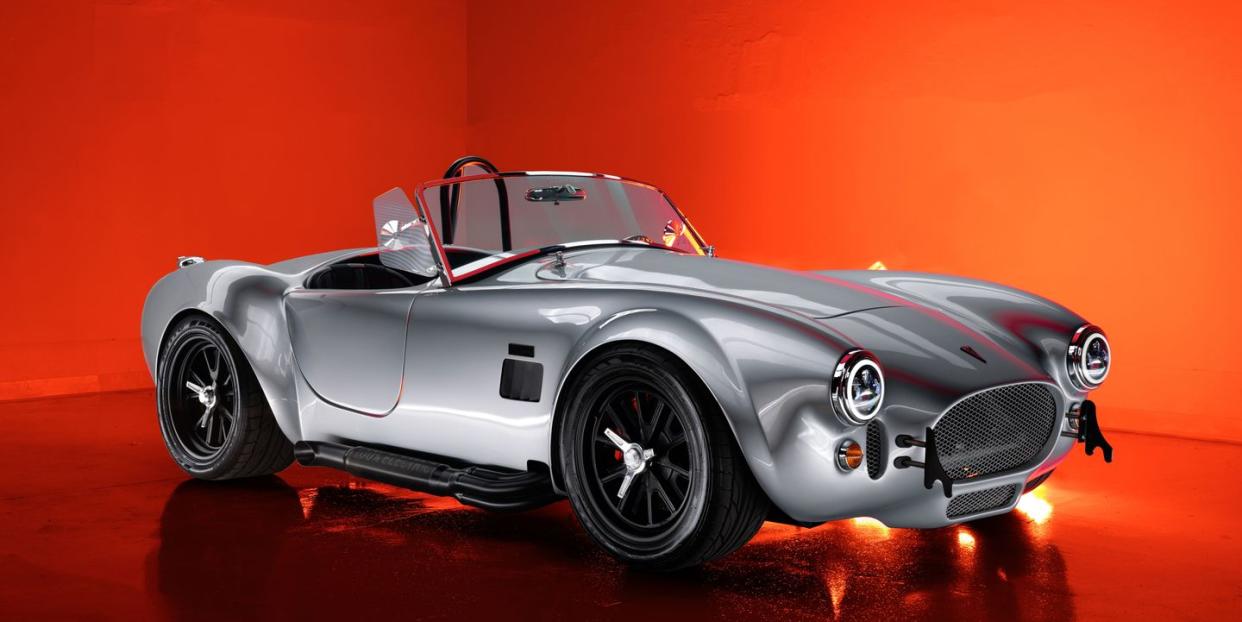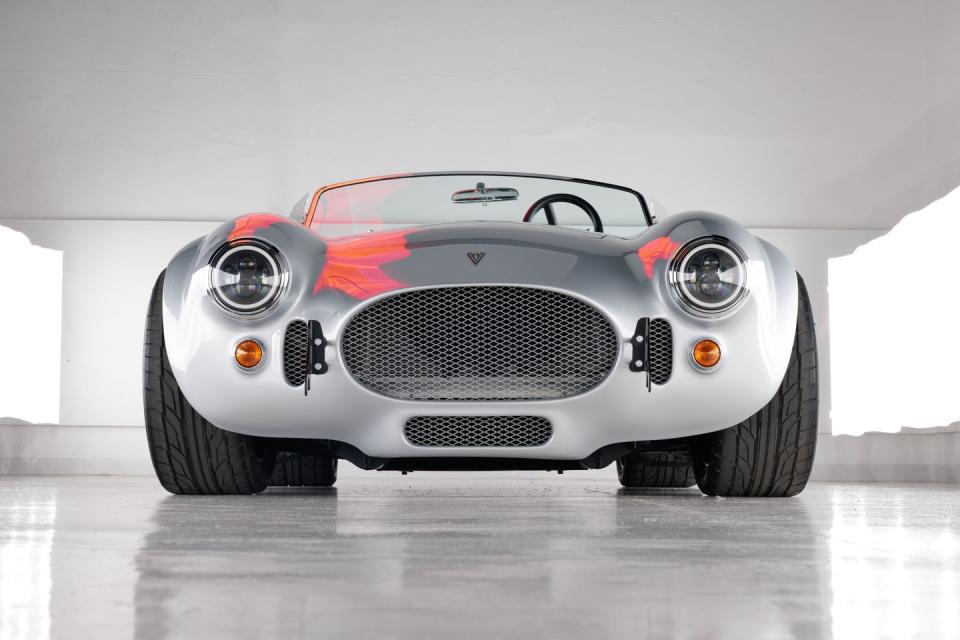Scorpion EV Is The Best of the Electric Cobras… So Far

Scorpion EV takes a Superformance Cobra and adds a powertrain from a Tesla Model S, though it’s not as simple as that.
There’s a 600-hp, rear-wheel-drive model and a 1000-hp, all-wheel-drive model.
Prices start at $185,000 for the 600-hp version.
Say, maybe this all-electric future they’re talking about won’t so bad after all. In fact, it could be downright thrilling.
Consider the all-electric Scorpion EV. It’s made in Temecula, California, from a Superformance Cobra. Scorpion adds a Tesla powertrain along with some proprietary controllers and software. The version I drove makes 600 hp and gets to 60 mph in a claimed 2.4 seconds. Stated range is 400 miles. And they’re in production now, with a sticker price of $185,000.
You may have seen articles about other electric Cobras, and there have been a few. Superformance itself showed one of its Cobra Mk IIIs that had been converted to electric power by GoTech Engineering in Florida. That one went on the media rounds last year, making various videographers giggle and squeak. But range is listed at only 100 miles, and production has proved elusive.
There’s an electric version of the Factory Five Mk4 Roadster out there, but it’s a kit that you have to build yourself. EV West sells a Factory Five EV conversion of its 818 model for just $8734. If you’re willing to cross the pond, AC Cars in the UK will sell you one of their Cobra Electric cars for £169,000, or Everrati one of its electric Superformance GT40 component cars.
So Scorpion seems to be further along than its competition, surprising for a company only founded in 2019.
“We’re not trying to replace the original format of this vehicle,” said company founder and CEO Guilherme “Bill” Cardoso. “What we’re trying to do is show what the next generation of this platform looks like. Shelby in the ‘60s innovated by picking up what became an iconic body from A/C in England, brought it to America and put a 289 or 427 Ford motor to make this car ridiculously fast. So what we’re doing is the next generation of that, and the next generation of speed and performance is an electric motor.”

Both the electric motor and the battery are from the Tesla Model S. The motor in the car I drove sits at the rear axle and powers the rear wheels. A future Scorpion EV model will have motors front and rear. The battery pack is reconfigured from Tesla’s flat tray of cylindrical batteries to fit into spaces in the Superformance Cobra.
“The center of gravity of this car is good,” Cardoso said. “The driver already sits so low, we didn’t have room to put the batteries under (the floor as on the Tesla Model S). So we used SolidWorks, which is a CAD program for mechanical design, and with SolidWorks we designed a front battery box and a rear battery box and we ran finite element analysis simulations to properly balanced the car 50/50.”
That required splitting the battery pack in two in order to balance the car. Likewise, the independent rear suspension had to be redesigned to accommodate the relatively large Tesla motor.
“So we did all this engineering work on the computer first, did all the simulation. And then we had all the pieces waterjet or laser cut, TIG welded, and then put it in and assembled.”
From there they can put a car together in about two weeks.
“We are shipping vehicles now with a lead time of 90 days. So three months lead time, and that accounts for paint, bodywork, testing, and everything else.”
But this isn’t just a Tesla motor in a Superformance body—there’s more to it. Cardoso has a PhD (and a BS and MS) in electrical and computer engineering from IIT.
“The Tesla, you can’t really pull a Tesla and just use all electronics, there’s a lot of proprietary handshakes that happen. And I really wanted to have as much control as possible and be able to tweak things like I showed you, changing the power output and the region on the fly.”

At the start of my drive in the Scorpion EV, the power was dialed all the way up to 600. Naturally, I floored it. Now, either I had great throttle control or there was some sophisticated traction control at work.
“There’s no traction control,” Cardosa said.
So I have great throttle control. In any case, the rears did spin, but not uncontrollably. It was quick, but not like a Rimac Nevera, Pininfarina Battista, or even a Tesla Model S in it’s more powerful mode. A little throttle—excuse me, accelerator—modulation kept the Scorpion EV in line as it launched. I wasn’t timing it but it sure felt like at least a 3- or 4-second 0-60 mph; maybe not quite as quick as a 2.4 as Cardosa claimed, but it’s possible that would come with even better control of the gas, er, accelerator pedal.
Remember, it’s not just a Tesla powertrain lifted out of a Model S and put in this. You can’t hack a Tesla.
“That’s very difficult to hack. I’m not saying it’s impossible, but it’s it hasn’t been done yet. What has been done, people have picked up the whole car, and place all the wires and all the sensors and the ECU and everything else from a Tesla and then just plopped that into a different chassis. That’s been done. But it’s again, that’s not the idea for this car. You want to keep it as nimble and as light as possible.”
So there was a lot of work involved?
“It was it was a lot of work, yes. There’s a lot of intellectual property in the car as it relates to the integration of all these different pieces. Putting an LS or a Coyote into a different platform, you can’t just go on YouTube and find 50 other guys before you who have done it. There’s a lot of the EV integration. Even for OEMs this is still in its infancy, there’s a lot of figuring out as you go. And we also don’t benefit from 100 years of automotive experience like gasoline internal combustion has. There’s not a vast range of experts out there you can call and have them say, ‘Oh, yeah, connect this point.’ So it’s a lot of reverse engineering, a lot of understanding how different pieces go together to end up in a package like this.”
A little more driving in an industrial area with no traffic reveals that the car is sporty, nimble, and light. Cardosa says it’s 2600 pounds “wet,” which includes the batteries. I ask him if it gets heavier when the battery is fully charged. He laughs. Electrical engineering humor.
He dials the power down and the regen up using his phone.
“Fifty horsepower is more than enough for this car,” he said.
It’s like a valet mode, or a teenage driver mode, or a maximize-your-range mode. The actual range might be as high as 500 miles, given the lightweight body and overall efficiency.
How does Cardosa know there’s a market for yet another electric Cobra that costs $185,000?
“Initially, I wanted to build one for myself, right? And I started with that idea in mind. And as I started the build mine, a friend of a friend of a friend reached out to me and said, ‘Hey, can you make me one as well?’ And I thought, ‘Well, wait a minute, if two guys in the world want it, I might have a few more who want it.’ So the spark was lit to make more cars, and I’m slowly finding more and more people would actually interested in this in this package.”
So far they have delivered seven cars and have plans to make 25 to 50 in 2023. If you’re interested, contact Scorpion EV here. And enjoy the future.


